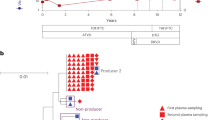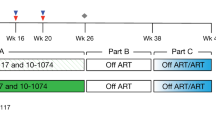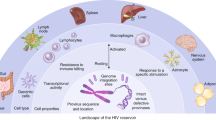Abstract
A hurdle for human immunodeficiency virus (HIV-1) therapy is the genomic diversity of circulating viruses and the possibility that drug-resistant virus variants are selected. Although RNA interference (RNAi) is a powerful tool to stably inhibit HIV-1 replication by the expression of antiviral short hairpin RNAs (shRNAs) in transduced T cells, this approach is also vulnerable to pre-existing genetic variation and the development of viral resistance through mutation. To prevent viral escape, we proposed to combine multiple shRNAs against important regions of the HIV-1 RNA genome, which should ideally be conserved in all HIV-1 subtypes. The vulnerability of RNAi therapy to viral escape has been studied for a single subtype B strain, but it is unclear whether the antiviral shRNAs can inhibit diverse virus isolates and subtypes, including drug-resistant variants that could be present in treated patients. To determine the breadth of the RNAi gene therapy approach, we studied the susceptibility of HIV-1 subtypes A–E and drug-resistant variants. In addition, we monitored the evolution of HIV-1 escape variants. We demonstrate that the combinatorial RNAi therapy is highly effective against most isolates, supporting the future testing of this gene therapy in appropriate in vivo models.
This is a preview of subscription content, access via your institution
Access options
Subscribe to this journal
Receive 12 print issues and online access
$259.00 per year
only $21.58 per issue
Buy this article
- Purchase on Springer Link
- Instant access to full article PDF
Prices may be subject to local taxes which are calculated during checkout




Similar content being viewed by others
References
UNAIDS. Reports on the global AIDS epidemic. 2013.
Hu WS, Temin HM . Genetic consequences of packaging two RNA genomes in one retroviral particle: pseudodiploidy and high rate of genetic recombination. Proc Natl Acad Sci USA 1990; 87: 1556–1560.
Roberts JD, Bebenek K, Kunkel TA . The accuracy of reverse transcriptase from HIV-1. Science 1988; 242: 1171–1173.
Geretti AM . HIV-1 subtypes: epidemiology and significance for HIV management. Curr Opin Infect Dis 2006; 19: 1–7.
Hemelaar J . The origin and diversity of the HIV-1 pandemic. Trends Mol Med 2012; 18: 182–192.
Thomson MM, Najera R . Molecular epidemiology of HIV-1 variants in the global AIDS pandemic: an update. AIDS Rev 2005; 7: 210–224.
Robertson DL, Anderson JP, Bradac JA, Carr JK, Foley B, Funkhouser RK et al. HIV-1 nomenclature proposal. Science 2000; 288: 55–56.
Gray GE, Allen M, Moodie Z, Churchyard G, Bekker LG, Nchabeleng M et al. Safety and efficacy of the HVTN 503/Phambili study of a clade-B-based HIV-1 vaccine in South Africa: a double-blind, randomised, placebo-controlled test-of-concept phase 2b study. Lancet Infect Dis 2011; 11: 507–515.
Hammer SM, Sobieszczyk ME, Janes H, Karuna ST, Mulligan MJ, Grove D et al. Efficacy trial of a DNA/rAd5 HIV-1 preventive vaccine. N Engl J Med 2013; 369: 2083–2092.
Katlama C, Deeks SG, Autran B, Martinez-Picado J, van LJ, Rouzioux C et al. Barriers to a cure for HIV: new ways to target and eradicate HIV-1 reservoirs. Lancet 2013; 381: 2109–2117.
Llibre JM, Buzon MJ, Massanella M, Esteve A, Dahl V, Puertas MC et al. Treatment intensification with raltegravir in subjects with sustained HIV-1 viraemia suppression: a randomized 48-week study. Antivir Ther 2012; 17: 355–364.
DiGiusto DL, Krishnan A, Li L, Li H, Li S, Rao A et al. RNA-based gene therapy for HIV with lentiviral vector-modified CD34(+) cells in patients undergoing transplantation for AIDS-related lymphoma. Sci Transl Med 2010; 2: 36–43.
Holt N, Wang J, Kim K, Friedman G, Wang X, Taupin V et al. Zinc finger nuclease-mediated CCR5 knockout hematopoietic stem cell transplantation controls HIV-1 in vivo. Nat Biotechnol 2010; 28: 839–847.
Shimizu S, Hong P, Arumugam B, Pokomo L, Boyer J, Koizumi N et al. A highly efficient short hairpin RNA potently down-regulates CCR5 expression in systemic lymphoid organs in the hu-BLT mouse model. Blood 2010; 115: 1534–1544.
Jacque JM, Triques K, Stevenson M . Modulation of HIV-1 replication by RNA interference. Nature 2002; 418: 435–438.
Qin XF, An DS, Chen IS, Baltimore D . Inhibiting HIV-1 infection in human T cells by lentiviral-mediated delivery of small interfering RNA against CCR5. Proc Natl Acad Sci USA 2003; 100: 183–188.
Ter Brake O, Konstantinova P, Ceylan M, Berkhout B . Silencing of HIV-1 with RNA interference: a multiple shRNA approach. Mol Ther 2006; 14: 883–892.
Brummelkamp TR, Bernards R, Agami R . A system for stable expression of short interfering RNAs in mammalian cells. Science 2002; 296: 550–553.
Ter Brake O, Berkhout B . Lentiviral vectors that carry anti-HIV shRNAs: problems and solutions. J Gene Med 2007; 9: 743–750.
Ter Brake O, Hooft K, Liu YP, Centlivre M, von Eije KJ, Berkhout B . Lentiviral vector design for multiple shRNA expression and durable HIV-1 inhibition. Mol Ther 2008; 16: 557–564.
von Eije KJ, Ter Brake O, Berkhout B . Human immunodeficiency virus type 1 escape is restricted when conserved genome sequences are targeted by RNA interference. J Virol 2008; 82: 2895–2903.
von Eije KJ, Ter Brake O, Berkhout B . Stringent testing identifies highly potent and escape-proof anti-HIV short hairpin RNAs. J Gene Med 2009; 11: 459–467.
Ter Brake O, Legrand N, von Eije KJ, Centlivre M, Spits H, Weijer K et al. Evaluation of safety and efficacy of RNAi against HIV-1 in the human immune system (Rag-2(−/−)gammac(−/−)) mouse model. Gene Ther 2009; 16: 148–153.
Eekels JJ, Pasternak AO, Schut AM, Geerts D, Jeeninga RE, Berkhout B . A competitive cell growth assay for the detection of subtle effects of gene transduction on cell proliferation. Gene Ther 2011; 19: 1058–1064.
Centlivre M, Legrand N, Klamer S, Liu YP, Eije KJ, Bohne M et al. Preclinical in vivo evaluation of the safety of a multi-shRNA-based gene therapy against HIV-1. Mol Ther Nucleic Acids 2013; 2: e120.
Boutimah F, Eekels JJ, Liu YP, Berkhout B . Antiviral strategies combining antiretroviral drugs with RNAi-mediated attack on HIV-1 and cellular co-factors. Antiviral Res 2013; 98: 121–129.
Herrera-Carrillo E, Liu YP, Berkhout B . The impact of unprotected T cells in RNAi-based gene therapy for HIV-AIDS. Mol Ther 2014; 22: 596–606.
Herrera-Carrillo E, Paxton WA, Berkhout B . The search for a T cell line for testing novel antiviral strategies against HIV-1 isolates of diverse receptor tropism and subtype origin. J Virol Methods 2014; 203C: 88–96.
Deng HK, Unutmaz D, KewalRamani VN, Littman DR . Expression cloning of new receptors used by simian and human immunodeficiency viruses. Nature 1997; 388: 296–300.
Gao F, Robertson DL, Carruthers CD, Morrison SG, Jian B, Chen Y et al. A comprehensive panel of near-full-length clones and reference sequences for non-subtype B isolates of human immunodeficiency virus type 1. J Virol 1998; 72: 5680–5698.
Liao F, Alkhatib G, Peden KW, Sharma G, Berger EA, Farber JM . STRL33, A novel chemokine receptor-like protein, functions as a fusion cofactor for both macrophage-tropic and T cell line-tropic HIV-1. J Exp Med 1997; 185: 2015–2023.
Pollakis G, Abebe A, Kliphuis A, Chalaby MI, Bakker M, Mengistu Y et al. Phenotypic and genotypic comparisons of CCR5- and CXCR4-tropic human immunodeficiency virus type 1 biological clones isolated from subtype C-infected individuals. J Virol 2004; 78: 2841–2852.
Rucker J, Edinger AL, Sharron M, Samson M, Lee B, Berson JF et al. Utilization of chemokine receptors, orphan receptors, and herpesvirus-encoded receptors by diverse human and simian immunodeficiency viruses. J Virol 1997; 71: 8999–9007.
Trkola A, Paxton WA, Monard SP, Hoxie JA, Siani MA, Thompson DA et al. Genetic subtype-independent inhibition of human immunodeficiency virus type 1 replication by CC and CXC chemokines. J Virol 1998; 72: 396–404.
van 't Wout AB, Blaak H, Ran LJ, Brouwer M, Kuiken C, Schuitemaker H . Evolution of syncytium-inducing and non-syncytium-inducing biological virus clones in relation to replication kinetics during the course of human immunodeficiency virus type 1 infection. J Virol 1998; 72: 5099–5107.
Markowitz M, Mohri H, Mehandru S, Shet A, Berry L, Kalyanaraman R et al. Infection with multidrug resistant, dual-tropic HIV-1 and rapid progression to AIDS: a case report. Lancet 2005; 365: 1031–1038.
Condra JH, Schleif WA, Blahy OM, Gabryelski LJ, Graham DJ, Quintero JC et al. In vivo emergence of HIV-1 variants resistant to multiple protease inhibitors. Nature 1995; 374: 569–571.
Dupnik KM, Gonzales MJ, Shafer RW . Most multidrug-resistant HIV-1 reverse transcriptase clones in plasma encode functional reverse transcriptase enzymes. Antivir Ther 2001; 6: 42.
Jacobsen H, Yasargil K, Winslow DL, Craig JC, Krohn A, Duncan IB et al. Characterization of human immunodeficiency virus type 1 mutants with decreased sensitivity to proteinase inhibitor Ro 31-8959. Virology 1995; 206: 527–534.
Otto MJ, Garber S, Winslow DL, Reid CD, Aldrich P, Jadhav PK et al. In vitro isolation and identification of human immunodeficiency virus (HIV) variants with reduced sensitivity to C-2 symmetrical inhibitors of HIV type 1 protease. Proc Natl Acad Sci USA 1993; 90: 7543–7547.
Reuman EC, Bachmann MH, Varghese V, Fessel WJ, Shafer RW . Panel of prototypical raltegravir-resistant infectious molecular clones in a novel integrase-deleted cloning vector. Antimicrob Agents Chemother 2010; 54: 934–936.
Schopman NC, Ter Brake O, Berkhout B . Anticipating and blocking HIV-1 escape by second generation antiviral shRNAs. Retrovirology 2010; 7: 52.
Back NK, Nijhuis M, Keulen W, Boucher CA, Oude Essink BO, van Kuilenburg AB et al. Reduced replication of 3TC-resistant HIV-1 variants in primary cells due to a processivity defect of the reverse transcriptase enzyme. EMBO J 1996; 15: 4040–4049.
Westerhout EM, Ooms M, Vink M, Das AT, Berkhout B . HIV-1 can escape from RNA interference by evolving an alternative structure in its RNA genome. Nucleic Acids Res 2005; 33: 796–804.
Martinez MA, Vartanian JP, Wain-Hobson S . Hypermutagenesis of RNA using human immunodeficiency virus type 1 reverse transcriptase and biased dNTP concentrations. Proc Natl Acad Sci USA 1994; 91: 11787–11791.
Berkhout B, de RA . APOBEC3G versus reverse transcriptase in the generation of HIV-1 drug-resistance mutations. AIDS 2004; 18: 1861–1863.
Keulen W, Boucher C, Berkhout B . Nucleotide substitution patterns can predict the requirements for drug-resistance of HIV-1 proteins. Antiviral Res 1996; 31: 45–57.
Vartanian JP, Meyerhans A, Asjo B, Wain-Hobson S . Selection, recombination, and G-A hypermutation of human immunodeficiency virus type 1 genomes. J Virol 1991; 65: 1779–1788.
Eekels JJ, Geerts D, Jeeninga RE, Berkhout B . Long-term inhibition of HIV-1 replication with RNA interference against cellular co-factors. Antiviral Res 2011; 89: 43–53.
Anderson JS, Walker J, Nolta JA, Bauer G . Specific transduction of HIV-susceptible cells for CCR5 knockdown and resistance to HIV infection: a novel method for targeted gene therapy and intracellular immunization. J Acquir Immune Defic Syndr 2009; 52: 152–161.
Li MJ, Kim J, Li S, Zaia J, Yee JK, Anderson J et al. Long-term inhibition of HIV-1 infection in primary hematopoietic cells by lentiviral vector delivery of a triple combination of anti-HIV shRNA, anti-CCR5 ribozyme, and a nucleolar-localizing TAR decoy. Mol Ther 2005; 12: 900–909.
Westerhout EM, Berkhout B . A systematic analysis of the effect of target RNA structure on RNA interference. Nucleic Acids Res 2007; 35: 4322–4330.
Kumar M, Keller B, Makalou N, Sutton RE . Systematic determination of the packaging limit of lentiviral vectors. Hum Gene Ther 2001; 12: 1893–1905.
Falkenhagen A, Ameli M, Asad S, Read SE, Joshi S . Gene therapy using a secreted single chain variable fragment targeting CCR5 to inhibit HIV infection. J Antivir Antiretrovir 2013; 5: 85–91.
Perez EE, Wang J, Miller JC, Jouvenot Y, Kim KA, Liu O et al. Establishment of HIV-1 resistance in CD4+ T cells by genome editing using zinc-finger nucleases. Nat Biotechnol 2008; 26: 808–816.
Swan CH, Buhler B, Steinberger P, Tschan MP, Barbas CF III, Torbett BE . T-cell protection and enrichment through lentiviral CCR5 intrabody gene delivery. Gene Ther 2006; 13: 1480–1492.
Egerer L, Volk A, Kahle J, Kimpel J, Brauer F, Hermann FG et al. Secreted antiviral entry inhibitory (SAVE) peptides for gene therapy of HIV infection. Mol Ther 2011; 19: 1236–1244.
van Lunzen J, Glaunsinger T, Stahmer I, von B, V, Baum C, Schilz A et al. Transfer of autologous gene-modified T cells in HIV-infected patients with advanced immunodeficiency and drug-resistant virus. Mol Ther 2007; 15: 1024–1033.
Eggink D, Langedijk JP, Bonvin AM, Deng Y, Lu M, Berkhout B et al. Detailed mechanistic insights into HIV-1 sensitivity to three generations of fusion inhibitors. J Biol Chem 2009; 284: 26941–26950.
Eggink D, Bontjer I, Langedijk JP, Berkhout B, Sanders RW . Resistance of human immunodeficiency virus type 1 to a third-generation fusion inhibitor requires multiple mutations in gp41 and is accompanied by a dramatic loss of gp41 function. J Virol 2011; 85: 10785–10797.
Seppen J, Rijnberg M, Cooreman MP, Oude Elferink RP . Lentiviral vectors for efficient transduction of isolated primary quiescent hepatocytes. J Hepatol 2002; 36: 459–465.
Lusso P, Cocchi F, Balotta C, Markham PD, Louie A, Farci P et al. Growth of macrophage-tropic and primary human immunodeficiency virus type 1 (HIV-1) isolates in a unique CD4+ T-cell clone (PM1): failure to downregulate CD4 and to interfere with cell-line-tropic HIV-1. J Virol 1995; 69: 3712–3720.
Ter Brake O, Westerink JT, Berkhout B . Lentiviral vector engineering for anti-HIV RNAi gene therapy. Methods Mol Biol 2010; 614: 201–213.
Peden K, Emerman M, Montagnier L . Changes in growth properties on passage in tissue culture of viruses derived from infectious molecular clones of HIV-1 LAI, HIV-1 MAL, and HIV-1 ELI. Virology 1991; 185: 661–672.
Acknowledgements
We thank the NIH AIDS Research and Reference Program (Division of AIDS, NIAID, NIH) for providing HIV-1 isolates. We are grateful to the participants of the Amsterdam Cohort Studies, collaboration between the Amsterdam Health Service, the Academic Medical Center of the University of Amsterdam and Sanquin Blood Supply Foundation. We thank Berend Hooibrink (AMC Cell Biology) for live-cell sorting. RNAi research in the Berkhout lab is sponsored by NWO-CW (Top Grant) and ZonMw (Translational Gene Therapy Grant).
Author information
Authors and Affiliations
Corresponding author
Ethics declarations
Competing interests
The authors declare no conflict of interest.
Rights and permissions
About this article
Cite this article
Herrera-Carrillo, E., Berkhout, B. The impact of HIV-1 genetic diversity on the efficacy of a combinatorial RNAi-based gene therapy. Gene Ther 22, 485–495 (2015). https://doi.org/10.1038/gt.2015.11
Received:
Revised:
Accepted:
Published:
Issue Date:
DOI: https://doi.org/10.1038/gt.2015.11
This article is cited by
-
Multiplexed shRNA-miRs as a candidate for anti HIV-1 therapy: strategies, challenges, and future potential
Journal of Genetic Engineering and Biotechnology (2022)
-
Specific properties of shRNA-mediated CCR5 downregulation that enhance the inhibition of HIV-1 infection in combination with shRNA targeting HIV-1 rev
Molecular Biology Reports (2022)
-
Rapid Regeneration and Reuse of Silica Columns from PCR Purification and Gel Extraction Kits
Scientific Reports (2018)
-
How close are we to therapies for Sanfilippo disease?
Metabolic Brain Disease (2018)



